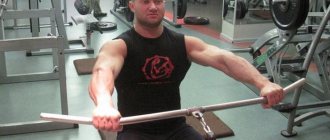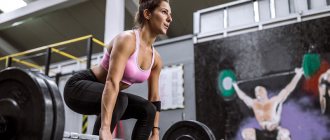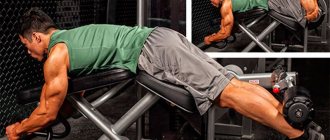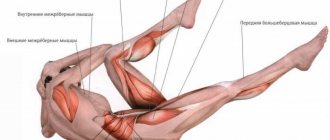If you think that your back muscles cannot be pumped up with dumbbells, then you are mistaken. And this can be done through the dumbbell row exercise. It can be performed either with each hand in turn, or with both hands tilted towards the waist.
The bent over dumbbell row is an effective basic classic exercise that can help you effectively develop your back muscles, as well as give them strength and definition.
The exercise is aimed primarily at developing the thickness of the back muscles. Regular exercise will lead to muscle growth in the target muscle group and give the figure a masculine, athletic V-shaped silhouette, which is so highly valued in bodybuilding and fitness.
Working muscles
Bent-over dumbbell rows are primarily aimed at pumping the latissimus dorsi muscles. Correct execution involves the greatest load on them.
Additionally, the following muscles are involved:
- Teres major muscles;
- Trapezoid;
- Back extensors;
- Rear deltoids;
- Rhomboid muscles;
- Biceps and forearms.
The exercise helps develop the thickness of the upper back, as well as its middle. Performing rows also requires significant participation of the rotator cuff, therefore, when performed correctly, the interscapular areas of the back muscles and the muscles that are located just below are actively activated. However, many people doing bent over rows do the exercise without feeling the contraction of the back muscles and “spread” the load across all the muscles.
As already mentioned, you can pump your back either with one dumbbell or with two dumbbells at the same time. In this case, the torso can be located either in a standing position, or with the knee of one leg resting on the bench, or even in a prone position on the bench. All of these exercise options are discussed below.
Benefits of Dumbbell Rows
Key features of the bent over dumbbell row include:
No. 1. Heavy load usage and execution safety.
The exercise is performed with free weight and is basic multi-joint in nature. The exercise allows you to work with a heavy load, while the load on the spine is minimal, so the exercise is a good option for people with lower back problems.
No. 2. Accessibility and use of free weights.
Bent-over dumbbell rows effectively strengthen the back muscles and do not require special training equipment or complex equipment. Therefore, the dumbbell row can be used as an exercise in the initial stages of training, as well as for home training.
No. 3. Variability of execution.
Because deadlifts use free weights, dumbbell rows can be performed from different positions and angles, allowing you to better feel your back muscles and get the most out of all areas of your back.
Other positive effects
In addition, bent over dumbbell rows can strengthen your lumbar region, improve your posture, get rid of hunched shoulders and keep your back muscles toned.
One-arm bent-over row with emphasis on the leg
Performing the exercise with emphasis on the leg is identical to the previous one, however, with this option, the back is not parallel to the floor, as with a bench, its inclination is 45 degrees.
- When pulling with an emphasis on the thigh, the athlete fixes the position with the emphasis of the arms and legs.
- The supporting leg should be bent at the knee, and the other leg should be set back.
Otherwise, the exercise is performed identically to the option of bending over on a bench.
Execution technique
The exercise is best performed using a bench (horizontal or inclined) or another fulcrum (a row of dumbbells).
One-arm dumbbell row
Starting position: lean the knee of your left leg on the bench, also lean on the bench with your left hand. The angle between the legs and body at the hip joint should be straight. Keep your back straight, arched in the lumbar region. This arched position of the lower back allows you to keep the spine in the position necessary for correct execution of the exercise. At the same time, the right leg is slightly pulled back and placed on the floor to maintain balance.
Don't lift your neck too high or twist it. The chin is parallel to the floor and the gaze is directed forward. For convenience, it is better to place the dumbbell next to the bench.
- From the starting position, take the dumbbell so that its bar is parallel to your body.
- Contracting your lat muscles, pull the dumbbell towards your waist. At the same time, the elbow is retracted as much as possible.
- At the peak point of contraction, it is recommended to linger for 1-2 seconds and additionally feel the tension in the working back muscles. Keep your spine straight.
- Then lower the dumbbell back down to the starting position. If possible, move the dumbbell back a little, rather than just lifting it perpendicular to the floor. Otherwise, you will perform pull-downs towards the chest, and not towards the waist, which is incorrect from the point of view of execution technique.
Perform 8-12 repetitions for 3-4 sets with each arm.
When performing, it is necessary to keep the body motionless so that the spine does not twist. Do not raise your elbow too high, as this will inevitably cause spinal rotation.
If it is difficult for you to keep your lower back arched while performing bent over dumbbell rows with one hand on a horizontal bench, you can use an incline bench. For what:
- Set the incline of the bench to 30 degrees.
- Raise the seat of the bench up slightly and stand on it with your knee as well.
- Bend the arm corresponding to the side of the body that is on the bench slightly at the elbow and rest it on the upper part of the back of the bench. As a result, you will be able, while maintaining the load, to keep your back straight and arched in the lower back due to the bend of the bench.
If this implementation turns out to be more convenient for you than in a traditional warrant, then do dumbbell rows in this version.
Row of two dumbbells to the belt
This variation of the exercise is performed both in a standing position and in a lying position on an inclined bench. Each hand should hold the dumbbells using the grip that is most comfortable for you.
Standing two dumbbell row
Let's look at the technique of performing rows of two dumbbells to the belt without a bench:
- To begin, bend your knees slightly, keep your back straight, and bend over until your back is just above parallel with the floor. At the same time, the areas of the back muscles that will bear the load depend on the degree of inclination. If you stand with a slight inclination, your upper back will work more. If you bend closer to a parallel position, the latissimus muscles will be activated more strongly, however, a stronger load will be placed on the lumbar region. We recommend using a tilt of approximately 45 degrees. Look straight, chin parallel to the floor.
- Place both dumbbells on straight arms directly under your shoulders with your arms perpendicular to the floor.
- Begin to row the dumbbells straight up, do not spread them to the sides. Try to pull the weight with your elbows towards your waist. Watch your elbows; the correct technique depends on the amplitude and direction of movement. Pause for 1-2 seconds at the top and lower the dumbbells to the starting position. Try to stretch your back muscles by lowering your hands with dumbbells as low as possible, but at the same time, do not completely relax your back muscles.
Do 3-4 sets of 10 reps each.
Please note that the weight must be pulled using the strength of the back muscles, and not due to the biceps brachii muscle.
It is not recommended to use one dumbbell for two-handed rows. In this case, you will not be able to maintain the required range of motion, as a result of which the exercise will not be effective.
Bent over row of two dumbbells
Set the angle of the incline bench to 30 degrees relative to the floor. Lie on your stomach so that your neck is free and your head is higher than the edge of the backrest. Your arms should be straight, but not touching the floor.
Place the dumbbells at the base of the bench so that you can reach them with your hands. Push your feet so that your body is in a stable position. Don't make the backrest angle too large, otherwise you will slide down.
The movement is performed in the same way as in the standing variation. This option provides you with an isolated load on the back muscles, since the fixed position of the body excludes the back extensor muscles from working. In addition, the lower back does not receive traumatic stress.
Errors
Check out common mistakes when doing exercises:
- Do not lower your head down, as you will disrupt the natural deflection of the spine, which leads to an increased risk of injury during the dumbbell row.
- Do not pull the dumbbell towards your chest. If you find it difficult to pull towards your waist, try reducing the weight.
- Do not use jerks when performing. Otherwise, you will not be able to effectively work your muscles, moreover, it may lead to injury.
- Don't round your back. If you lack flexibility or find it difficult to maintain balance with an arched back, you can use the incline bench option.
- If you experience discomfort in your hand resting on the bench (shaking, weakness), this means that you should use an incline bench for now, or try a cable variation or another hand position.
- Do not spread your arms, but pull the dumbbells, which should be held freely by your forearms and simply hang down.
- Do not use excessive weight and pull the implement through its full range of motion. If it is difficult for you to raise your elbows to the required height, then you should reduce the working weight.
- Use the strength of your back muscles to pull dumbbells. Imagine that your arms are just hooks that lift the weight.
- Insufficient bending when standing bent over dumbbell rows.
Exhale with effort (dumbbell pull), and lower with inhalation.
Common mistakes
- dumbbell rows using the biceps rather than the forearm and back muscles;
- lumbar rotations;
- flexion of the spine in the form of the letter “C”;
- abduction of the elbow to the side;
- jerks in movements;
- lowering of the pelvis and head too low;
- high elevation of the pelvis and head.
Most often, beginners make several mistakes.
- Performing exercises with heavy weights without a bench. A large weight immediately overwhelms an athlete, even if he is very strong. The additional load has to be compensated by stabilizer muscles. As a result, the body loses stability, and this is fraught with injury.
- Haste. It appears if the weight of the dumbbell is insufficient. Jerks lead to inertia, inertia reduces the effectiveness of the exercise.
- Rotation of the body, lowered head and rounded back. Both errors are unacceptable.
- The dumbbell rises to the chest. This happens when an athlete overestimates his capabilities and lifts too much weight.
Accordingly, we can conclude that bent over rows should be performed:
- with the correct weight;
- slowly, controlling all the muscles involved in the work;
- clearly fix the position of the body.
- Shoulder collapse at the lowest point. As already mentioned, the position of the body must be fixed strictly parallel to the floor.
- Rotation of the body at the waist at the top point. In this case, the lower back receives a large load, and the target muscles do not work.
- Rounding the back. To avoid this problem, keep your chin up and choose the right weight.
- Raising a dumbbell using the muscles of the arm. Here it is important to focus your attention on the work of the target muscles. You should clearly feel the work of the latter.
- Raising your elbows to the side. To maximally engage the target muscles, raise your elbow as high as possible and do not pull it to the side.
To finally understand the technique, we suggest you watch the following video.
Each exercise has its own nuances and subtleties of implementation. The dumbbell row is no exception. Moreover, we are dealing with back training. Therefore, there are a lot of nuances here. To ensure that your training is as productive as possible, and, most importantly, does not injure you, try to avoid the following mistakes:
- Rotating your back is dangerous for your spine. The movement should be carried out by lifting the shoulder blade, and not by rotating the back.
- Rounding your back is a serious mistake when performing any exercise. Especially here, such a mistake can be disastrous. After all, when performing an approach, your lower back receives a static load, and rounding your back can lead to injury to the vertebrae.
- Moving your elbow to the side is a mistake that will get you nowhere. That is, neither to injury nor to the desired result. If you move your elbow to the side, your biceps and rear deltoids will work actively. We don't need them here, because we're shaking our backs.
- Movement in a short amplitude will reduce the effectiveness of your workout. In order to pump the back muscles well, it is necessary that at the top point the elbow is higher than shoulder level.
- Lowering the inactive shoulder. While performing the deadlift, your back should be motionless. If you raise one shoulder at the expense of lowering the other, the exercise will not benefit you. You will simply waste your energy on something unknown.
Adviсe
If you use different angles between the arm and torso during the pull, you can mix the load on different parts of the muscles. If you spread your elbows wide, the rear deltoids are actively involved in the exercise. The latissimus dorsi muscles work best when the elbows are closer to the body, as when gripping a regular barbell.
Thus, you can pump up certain areas of your back, from time to time alternating, for example, the option with elbows near the body, and the option with widely spaced elbows. And do not forget to pull the projectile towards your belt, otherwise the effectiveness of the exercise will decrease.
- during execution, the forearms do not actively work to bring the projectile upward;
- do not release the load while excessively straightening your arm at the lowest point throughout the entire range of motion;
- pull the dumbbell to its full amplitude without shortening it, for which you should select a moderate weight;
- keep the shoulder of your working arm in a fixed position, do not lower it at the lowest point;
- try to raise your elbow with the apparatus as high as possible, without pulling the dumbbell to the side;
- do not round your back, and also keep your head straight, do not look down;
- It’s better if there was a mirror in front of you when performing the exercise, this will allow you to control the process of execution;
- if you work with heavy weights, it is recommended to use special traction straps to hold and relieve the load from your hands;
How to hold a dumbbell when deadlifting
When pulling two dumbbells to the belt, just like when pulling a barbell in an inclined position, you can hold them with different grips.
There will be no significant difference. Also note that by increasing the angle between the body and the shoulder (spreading the arms further), the position of the dumbbells will also change, they will turn more to the sides.
Once your back muscles are stronger, you will be able to use significant weights when performing dumbbell rows. However, be careful when choosing the working weight for the exercise, since excessive weight, especially when standing deadlifts, can lead to back damage. In addition, the execution technique will be disrupted, and you will have to pull using jerking movements.
Bent over dumbbell rows are an excellent exercise for girls to develop their back muscles. And also an excellent exercise for working out the relief as an isolated load after more difficult basic exercises.
Who should do it?
Bent-over rows are a great exercise for anyone who wants to pump up their back muscles, increase their strength and achieve beautiful definition. This exercise cannot be called difficult; it is easily mastered by beginners in fitness and performed by experienced athletes:
- Beginners should focus on technique.
- For experienced athletes, increase the weight of the load and the number of repetitions.
In women's training, deadlifting is not considered the main exercise, but it must be done, since deadlifting strengthens the back muscles, forms its beautiful curve and prevents the deposition of fat under the skin. The belt row is part of the complexes for women, including this exercise, which is performed even in the strength part of aerobics training.
Experts in the field of healthy lifestyle claim that people who spend a lot of time in offices and lead a sedentary lifestyle usually “earn” scoliosis, that is, a curvature of the spinal column. Knowing his diagnosis and understanding how the imbalance developed, a person can help himself cope with the problem by performing dumbbell rows.
Possible problems and contraindications
- If you have problems with the rear deltoid muscles, then it is not recommended for you to perform dumbbell rows. These areas of the deltoids will definitely be included in the work in any version of the exercises presented.
- If you don't have good stretching and flexibility in your joints, you will have a hard time getting into the correct starting position with a backbend to perform the deadlift. Even if you use an incline bench, lying with your stomach face down, a deflection is required in the lumbar region. Therefore, it is recommended to warm up, stretch before performing this exercise and work on stretching.
Video - Bent-over dumbbell row:
Benefits and disadvantages
The exercises are energy intensive and can build strength and size in most back muscles. This will also be a great exercise for both men and women. The deadlift involves not only the back muscles, but also the central stabilizers. This type of row can also be performed on an incline bench. This provides the most stable position, reducing stress and the possibility of injury.
By changing the hold of the dumbbells (pressing your elbows to the body or like a barbell, spreading your elbows to the sides), you can change the emphasis of the load on one or another area of the back.
- In the elbows-out position, the load falls on the trapezius, teres major and minor, the back of the deltoid muscles and, of course, the rhomboid and latissimus dorsi muscles.
- When pressing your elbows to your body, the rhomboid and latissimus muscles receive the greatest load, while the remaining muscles are less loaded.
Lack of traction on the belt is a load on the spine. And athletes with injuries are not recommended to perform this exercise at all. Another thing is the incline bench press or deadlift with a T-bar. This option will suit almost everyone.











